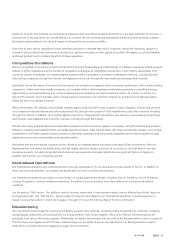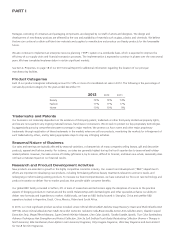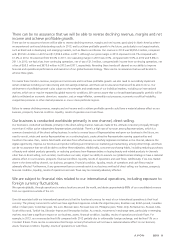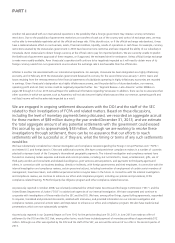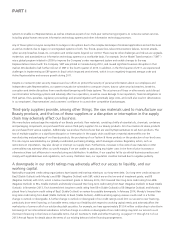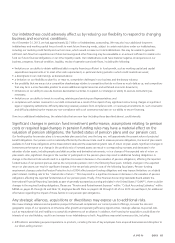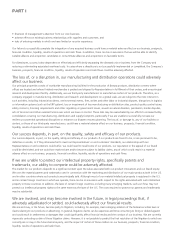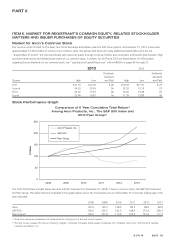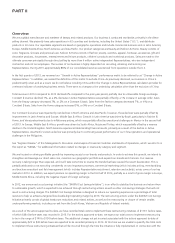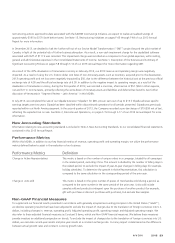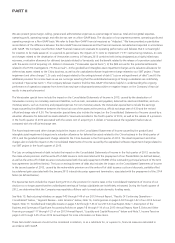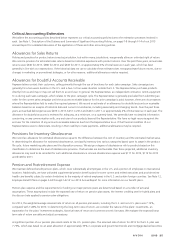Avon 2013 Annual Report Download - page 23
Download and view the complete annual report
Please find page 23 of the 2013 Avon annual report below. You can navigate through the pages in the report by either clicking on the pages listed below, or by using the keyword search tool below to find specific information within the annual report.Our indebtedness could adversely affect us by reducing our flexibility to respond to changing
business and economic conditions.
As of December 31, 2013, we had approximately $2.7 billion of indebtedness outstanding. We may also incur additional long-term
indebtedness and working capital lines of credit to meet future financing needs, subject to certain restrictions under our indebtedness,
including our revolving credit facility and our term loan, which would increase our total indebtedness. We may be unable to generate
sufficient cash flow from operations and future borrowings and other financing may be unavailable in an amount sufficient to enable us to
fund our future financial obligations or our other liquidity needs. Our indebtedness could have material negative consequences on our
business, prospects, financial condition, liquidity, results of operations and cash flows, including the following:
• limitations on our ability to obtain additional debt or equity financing sufficient to fund growth, such as working capital and capital
expenditures requirements or to meet other cash requirements, in particular during periods in which credit markets are weak;
• a downgrade in our credit ratings, as discussed above;
• a limitation on our flexibility to plan for, or react to, competitive challenges in our business and the beauty industry;
• the possibility that we are put at a competitive disadvantage relative to competitors that do not have as much debt as us, and competitors
that may be in a more favorable position to access additional capital resources and withstand economic downturns;
• limitations on our ability to execute business development activities to support our strategies or ability to execute restructuring as
necessary;
• limitations on our ability to invest in recruiting, retaining and servicing our Representatives; and
• compliance with certain covenants in our debt instruments as a result of the impact of any significant restructuring charges or significant
legal or regulatory settlements; difficulty obtaining necessary waivers from compliance with, or necessary amendments to, such covenants;
and difficulty addressing the impact any non-compliance with such covenants may have on our ability to secure financing.
If we incur additional indebtedness, the related risks that we now face (including those described above), could intensify.
Significant changes in pension fund investment performance, assumptions relating to pension
costs or required legal changes in pension funding rules may have a material effect on the
valuation of pension obligations, the funded status of pension plans and our pension cost.
Our funding policy for pension plans is to accumulate plan assets that, over the long run, will approximate the present value of projected
benefit obligations. Our pension cost is materially affected by the discount rate used to measure pension obligations, the level of plan assets
available to fund those obligations at the measurement date and the expected long-term rate of return on plan assets. Significant changes in
investment performance or a change in the portfolio mix of invested assets can result in corresponding increases and decreases in the
valuation of plan assets, including equity and debt securities and derivative instruments, or in a change of the expected rate of return on
plan assets. Also, significant changes in the number of participants in the pension plans may result in additional funding obligations. A
change in the discount rate would result in a significant increase or decrease in the valuation of pension obligations, affecting the reported
funded status of our pension plans as well as the net periodic pension cost in the following fiscal years. Similarly, changes in the expected
return on plan assets can result in significant changes in the net periodic pension cost of the following fiscal years. Pension funding
requirement changes under the Pension Protection Act of 2006 affect pension funding obligations and may impose limitations on a hybrid
plan’s interest crediting rate to the “market rate of return.” This may result in a significant increase or decrease in the valuation of pension
obligations affecting the reported funded status of our pension plans. Finally, if the Financial Accounting Standards Board adopts the
International Financial Reporting Standards as part of generally accepted accounting principles in the United States (“GAAP”), there could be
changes in the required funding obligations. Please see “Pension and Postretirement Expense” within “Critical Accounting Estimates” within
MD&A on pages 25 through 26 and Note 12, Employee Benefit Plans on pages F-34 through F-42 of our 2013 Annual Report, for additional
information regarding the impact of these factors on our pension plan obligations.
Any strategic alliances, acquisitions or divestitures may expose us to additional risks.
We review strategic alliances and acquisition prospects that would complement our current product offerings, increase the size and
geographic scope of our operations or otherwise offer growth and operating efficiency opportunities. Strategic alliances may entail risks
such as reputational risk and inability to successfully implement such an alliance. In addition, the financing for acquisitions could dilute the
interests of our stockholders, result in an increase in our indebtedness or both. Acquisitions may entail numerous risks, including:
• difficulties in assimilating acquired operations or products, including the loss of key employees from acquired businesses and disruption to
our direct-selling channel;
A V O N 2013 15


